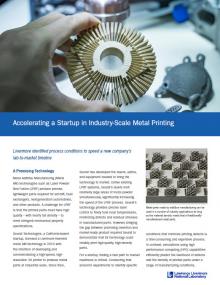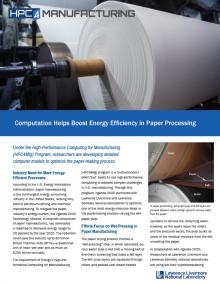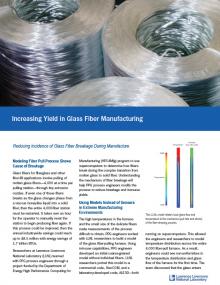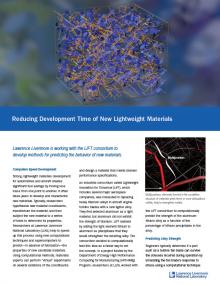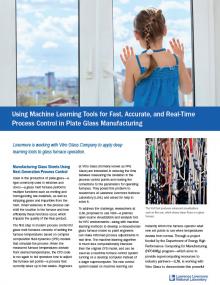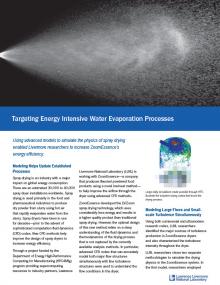Success Stories
Powered by Partnerships and Participation
Since its inception in 2015, the world-class computation capabilities and expertise at the national laboratories have addressed problems in steel and aluminum manufacture, jet turbine design and manufacture, advanced materials for light weighting and high temperature, high corrosion applications, chemical processing and many more topic areas.

11
Participating Labs

182
Projects Awarded

$55.9 million
Funds Invested

916 million
Computer Core Hours
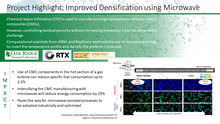
Microwave-assisted Ceramic Processing
Raytheon partnered with Oak Ridge National Laboratory to explore innovative approaches, notably microwave heating, to improve chemical vapor infiltration.
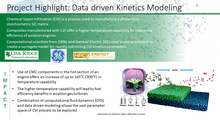
Data-driven Kinetics Modeling of Chemical Vapor Infiltration
General Electric and Oak Ridge National Laboratory used a neural network to create a surrogate model that can efficiently represent computationally intensive CFD calculations obtained from high performance computing, allowing the exploration of vast parameter space of the chemical vapor infiltration process and understanding of chemical kinetics.
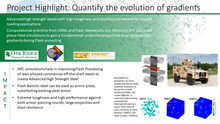
Microscopic Concentration Gradients
Flash Steelworks, Inc. collaborated with Oak Ridge National Laboratory to utilize phase field simulations to gain fundamental understanding of local composition gradients during flash annealing.
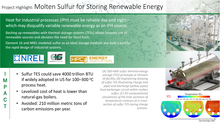
Molten-Sulfur Storage
National Renewable Energy Laboratory and Element 16 Technologies, Inc. partnered through HPC4Mfg to model sulfur as an ideal storage medium and built a tool for the rapid design of industrial systems.
Heat Exchangers
Lawrence Livermore National Laboratory and Materials Sciences, LLC partnered through HPC4Mfg to deploy topology optimization, additive manufacturing, machine learning, and utlra-high-powered computers to optimize exchanger physics and slash compressor energy consumption by 30%.
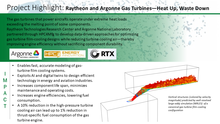
Gas Turbines and HPC
Argonne National Laboratory and Raytheon Technologies Research Center partnered through HPC4Mfg to develop data-driven approaches for optimizing gas turbine film-cooling designs while reducing turbine cooling air—thereby improving engine efficiency without sacrificing component durability.
Next Generation Additive Manufacturing
Livermore Lab is working with Seurat Technologies to model a faster laser powder bed manufacturing process and bring it to market.
Improved Aluminum Ingot Casting
Livermore Lab is working with Arconic to model Aluminum ingot casting and reduce cracking that leads to product rejection.
Next-Generation LEDs
Livermore Lab is working with light-emitting-diode (LED) manufacturer SORAA to create a new computer model of the company’s research-scale process for growing gallium nitride (GaN) crystals.
Energy Efficiency in Paper Processing
Agenda 2020 partnered with Livermore and Berkeley labs to optimize one of the most energy-intensive steps in the papermaking process—drying the wet paper pulp.

Your Success Story Awaits
HPC4EI brings together the diverse set of computational skills and supercomputing capabilities of DOE National Laboratories to increase US industry’s energy efficiency and advance competitiveness. Learn about the next opportunity to partner with the superb talent and high performance computing platforms at DOE National Laboratories.
Have questions?
Please email hpc4ei [at] llnl.gov (subject: HPC4EI%20Assistance%20%28Success%20Story%29) (hpc4ei[at]llnl[dot]gov) for further assistance.
Reducing Glass Fiber Breakage
PPG Industries is working with Livermore Lab to use supercomputers to modify the process of converting molten glass to solid fiber to reduce breakage and increase yields.
Optimizing Lightweight Materials
Livermore Lab is working with the LIFT consortium to develop methods for predicting the behavior of new lightweight materials for automobiles and aircraft.
Glass Furnace Model Enhancement
Livermore Lab is working with Vitro Glass Company to provide fast, accurate, and real-time process control in plate glass manufacturing.
Improve Water Evaporation Processes
Livermore Lab is working with Zoom Essence to help improve the design of spray dryers to increase energy efficiency.

